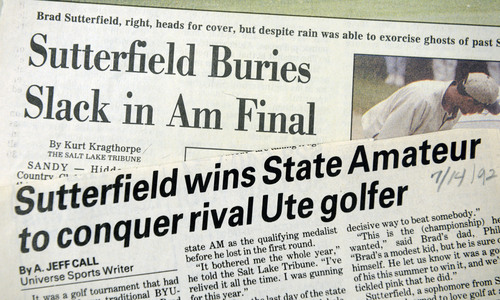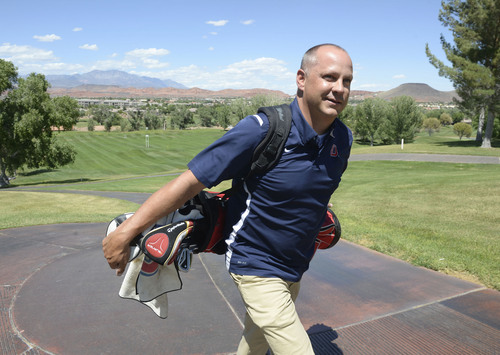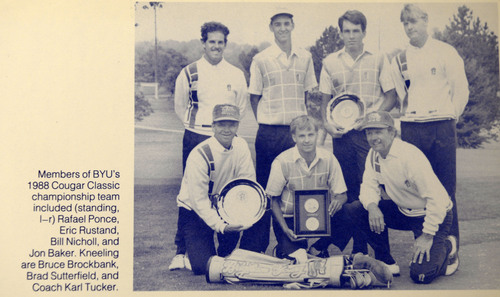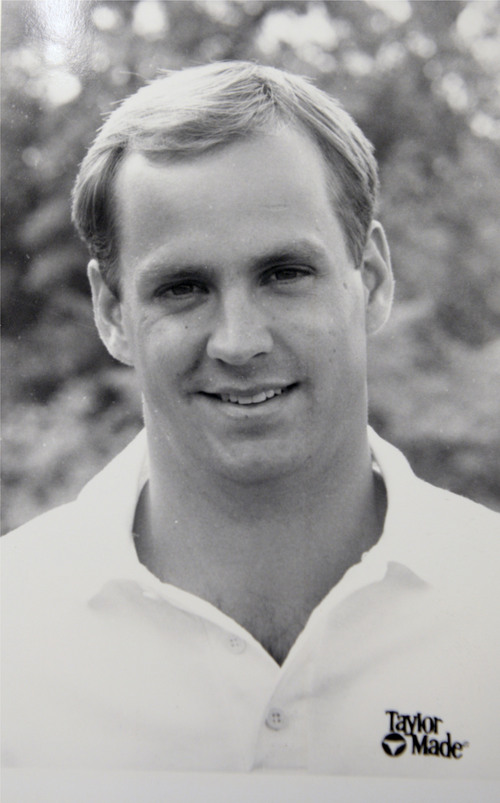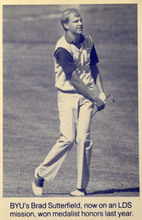This is an archived article that was published on sltrib.com in 2014, and information in the article may be outdated. It is provided only for personal research purposes and may not be reprinted.
St. George • Brad Sutterfield stood in the middle of the 18th fairway in Miami and glimpsed the Shark, right next to him.
The PGA Tour rookie's name appeared on a manual scoreboard at the course known as the Blue Monster, with "Sutterfield" right above "Norman" — the Great White Shark himself, Greg Norman.
And then Sutterfield knocked his 5-iron shot into the water. His biggest regret, 17 years later? Camera phones were not yet invented, so he couldn't document that scoreboard moment.
The snapshot of being close to golf greatness would have been worth preserving from Sutterfield's only season on the PGA Tour. Golf is the one professional sport that gives qualifiers exactly one year's access. That's all he got, while going until July without making a dollar and finishing with less than $19,000 (before subtracting travel expenses).
Sutterfield kept pursuing the game for another 10 years, with intermittent worldwide success. He won a Canadian Tour event in Austin, Texas. He claimed a European Challenge Tour title in Peru, and another in France. He played in 33 countries, including Kazakhstan and Russia, requiring extra pages for his passport. He gained limited access to the European Tour, but never played his way onto the PGA Tour again.
"I knew what it was like and how bad I wanted to get back," he said. "That was probably a detriment."
Sutterfield and his wife, Tanya, enjoyed their season as a PGA Tour couple. He laughs, remembering what seemed like a perk at the time: free long-distance calls in the clubhouse. Even as a non-golfer, she hit their most memorable shot of the year, a wood from 160 yards to within 8 inches of the hole, in a wives' event with her husband caddying. And he wishes he had kept her as his caddie, after she helped him get through the three qualifying stages.
Unlike other pro athletes, golfers can keep playing indefinitely. Sutterfield's pursuit of the game took him into his late 30s, before injuries, a growing family and the struggle to succeed converged to bring him home.
"Part of me was still playing for fear of what it would be like when I quit," he said on the veranda of Sunbrook Golf Club during a summer afternoon in St. George.
Sutterfield worked in real estate, golf teaching and telecommunications, while reintroducing himself to his wife and three daughters. In his European phase, he once spent six weeks away, came home for a week and left for another four weeks.
"We had to get used to him … this interloper in our lives," Tanya Sutterfield said, half-kiddingly. "But we figured it out."
Sutterfield eventually found a job he loves, becoming Dixie State University's men's golf coach in 2012. That's a part-time position, so he also processes mortgage loans and recent completed an MBA from Western Governors University. All of that has left little time to play golf, but when he does play, he enjoys it.
"I like playing now more than I did when I was competing, because now it doesn't matter," said Sutterfield, 45. "It didn't matter, but I made it seem like it did. I'll go out now and I'll laugh at some of the shots that I hit."
Sutterfield is convinced that a more relaxed, healthy attitude about the game would have served him better. That's what he tries to convey to his Dixie State players — to not act like he did, basically. So he treats them like little leaguers in some ways, offering trips to Dairy Queen as incentive during practice rounds, but also demands that they behave on the course, with no temper-driven outbursts.
"He doesn't take crap if you're being immature," said Red Storm golfer Skylar Schone, noting that Sutterfield focuses less on swing mechanics and more on "ball control, course management and self-management."
The players love to hear his pro golf stories, such as competing with Rory McIlroy in Europe. He also can claim to have beaten Tiger Woods in the 1997 Canadian Open and once spent a Saturday evening watching his name crawl across the CNN ticker among the leaders in the Quad Cities Open.
He faded to a tie for 23rd place, missing his only real opportunity for a big check during a rough season when his low status — based on his qualifying tournament finish — limited him to 20 starts. That's among the complications that make it tough stay on the tour.
Near the end of that season, while playing in Las Vegas, Sutterfield said, "I would say to anybody: Go play the PGA Tour for a year, and we'll talk."
He knows that sounds harsh, 17 years later, reflecting his frustration with not living up to expectations — especially his own. Looking back, he said, "I didn't have enough confidence. I wasn't ready, probably, to get out there."
So the irony is that while former BYU teammates Mike Weir and Dean Wilson took longer to make the tour, they were better prepared to stay.
Something else Sutterfield said that day in Las Vegas resonates: "Life's not over."
Ten years later, when he gave up golf, those words became more frightening than reassuring. "I played golf for a living," he said. "Now what?"
His career evolution has led him back to the course, coaching golfers he hopes will have more fun that he did. When they're disgusted, the 2014 PacWest coach of the year sees his younger self. "That's exactly how I used to react," he said. "It's so much easier to play the other way. 'Hey, relax a little. Enjoy this.' "
The opportunity may remain for Sutterfield to put those words into practice. He caddied for Sandy's Steve Schneiter in the recent U.S. Senior Open in Oklahoma, re-entering the pro golf world.
Wrapping that conversation in St. George, Sutterfield acknowledged thoughts of a Champions Tour qualifying effort when he's 50. "Five years away," he said, "but it'll go quick."
Twitter: @tribkurt —
About the series
What if you could play one year at the highest level of a sport? How would you view that experience and how would you spend the rest of your life? Utah high school graduates Fui Vakapuna, Zach Sorensen, Brad Sutterfield and Britton Johnsen each realized a lifelong dream, and then his opportunity was gone. These are their stories.
Today • Brad Sutterfield —
About Brad Sutterfield
Age • 45.
High school • Brighton.
College • BYU.
PGA Tour experience • 20 tournaments, 1997.
Family • Wife, Tanya, daughters Drew (15), Camryn (10), Avery (7).
Jobs • Dixie State University men's golf coach; loan officer, Patriot Home Mortgage.
Notable • Sutterfield played for legendary BYU coach Karl Tucker's last team in 1992 and became the first golfer among his teammates to make the PGA Tour, ahead of Mike Weir and Dean Wilson.
Different path • In the PGA Tour's new system, golfers who advance through the annual qualifying tournament become Web.com Tour members, with a full season determining their PGA Tour eligibility. Formerly, qualifiers such as Brad Sutterfield went directly to the PGA Tour. Having the Web.com Tour experience "would have been better," Sutterfield said. "The flip side is, how can you turn down an opportunity to play the PGA Tour?"



